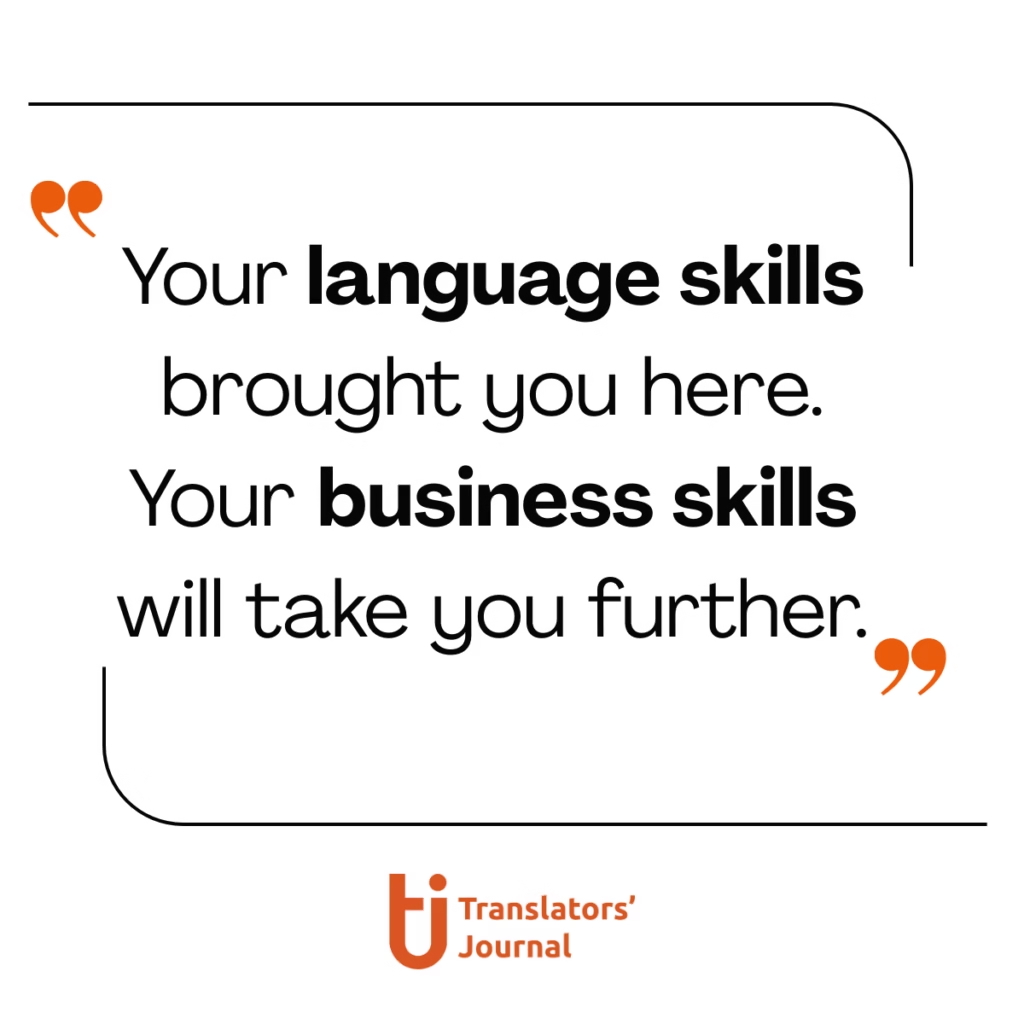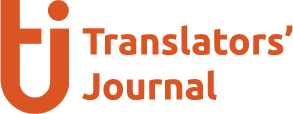If you’re a freelance translator and among the best in your language pair or specialty, you already know that simply being the best doesn’t guarantee you’ll earn more as a translator.
More often than not, it’s about being in the right place, making the right connections, and taking strategic steps that lead to greater income.
People who commission you are most likely to represent other businesses. And as a freelance translator, you’re helping them enter new markets, reach communities, or share their voice across borders.
So you too need to work as a business.
You need to know who are your clients, how you find them, how you add values, how to price your work, and keep your income stable year-round.
Everything comes down to understanding the freelance translation business model first.
Let’s dive in!
The Two Sides of Your Business
Let’s start with recognizing the two sides of your business.
Probably you noticed that It’s not the end readers who pay you for your translation work.
Translation clients are decision-makers running businesses, focused on results, budgets, and return on investment.
At their core, these clients are businesses, not readers. So to get rewarded by them, you need to think and act like a business yourself.
There’s no doubt that translation is a craft. That helps you connect your readers. But it’s also a business. And to thrive as a freelance translator, you have to master both:
- Your Craft
- Your Business Skills

The Freelance Translation Business Model
At its core, the freelance translation business works like this:
Someone pays you to translate something they either can’t or don’t want to do themselves.
That’s the essence of the value you provide.
So, to build a sustainable translation business, you need to clearly answer three fundamental questions:
- Who can pay you? (Your target clients)
- What can you translate? (Your skillset and niche)
- How much can you charge? (Your pricing strategy)
Depending on these answers, you’ll get a realistic picture of whether your rates and market can support your income goals.
An honest and realistic answer to each of these question tells you if your language pair, your specific knowledge and skills set have income potential.
Here’s a detailed step-by-step guide to your freelance translation business blueprint:
- Find people who need something translated.
This could be companies, agencies, publishers, NGOs, or even individuals. anyone who has words they can’t read or share.
(This is your “market.”) - Offer to do it for a price.
Tell them you can do it. That’s marketing. Email them, meet them, or make it easy for them to find you. Agree on a price before starting.
(This is your “offer.”) - Do the job well and deliver on time.
Quality plus reliability equals repeat clients and referrals.
(This is your “product.”) - Charge more than it costs you to do the work.
Make sure you charge higher than your costs. Your costs include time, tools, software, taxes, and living expenses.
(This is your “profit margin.”) - Repeat and grow.
Keep your best clients, let go of the problematic ones, and raise your rates as your skills and demand increase.
Different Business Models for Freelance Translators
Let’s lay out some of the business models you can choose for your freelance translation business.
A. Freelance Platform Model
You rely on platforms like Upwork, ProZ, Fiverr, or others to find and secure translation work. Competitive, but with the right strategy, they can connect you to valuable long-term clients.
- Pros: Quick access to a global pool of clients, easy entry point for beginners, built-in payment security.
- Cons: Highly competitive, race-to-the-bottom pricing unless you position yourself carefully, platform fees eat into earnings.
- Best for: Beginners building a portfolio, or experienced translators who know how to stand out and filter high-quality clients.
- Challenges: You’ll need to master profile optimization, proposal writing, and niche positioning to avoid being stuck with low-paying gigs. Building lasting client relationships outside the platform can also be tricky.
B. Agency-Focused Model
You work mainly with multiple reliable agencies with proven relationships and volume of projects.
- Clients: Language Service Providers or translation agencies
- Pros: Consistent flow of projects, less need to handle sales.
- Cons: Lower rates, less direct contact with end clients.
- Best for: Translators who want predictability and low marketing effort.
- Challenges: Work is not guaranteed unless you have a formal contract. You’ll likely need to collaborate with several agencies before identifying the few that can consistently provide projects suited to you.
C. Direct-Client Specialist Model
You focus on one niche (e.g., legal, medical, financial, technical, marketing) and secure long-term contracts with direct clients.
- Clients: Companies, NGOs, law firms, marketing agencies, healthcare providers, tech firms, etc.
- Pros: Freedom to set your own rates, stronger long-term relationships, recurring work, and higher earning potential.
- Cons: Requires significant marketing, networking, and admin work (contracts, invoicing, client support).
- Best for: Mid-career professionals with strong niche expertise and the ability to handle the business side of freelancing.
- Challenges: Building trust takes time; landing the first few clients is the hardest part. You need excellent communication and negotiation skills, plus the capacity to deliver consistent quality under pressure.
D. Creator-Translator Hybrid
You create your own products or content (courses, books, blogs, podcasts, YouTube, newsletters) and use translation both as a service and as a marketing tool to grow your audience.
- Pros: Diversified income streams, creative freedom, authority-building in your niche.
- Cons: Takes time and consistency to build an audience; income may be slow and unpredictable at first.
- Best for: Translators who enjoy teaching, writing, or media creation, and who want to combine freelancing with thought leadership.
- Challenges: Requires strong branding, patience, and persistence. Balancing content creation with client work can be tough, and monetization often comes only after months (or years) of steady publishing.
Choose The Business Model That Fits You
What business model would work for you depends on your personal goals and circumstances:
- Your income needs: Are you aiming for $500/month side income or $5,000+ full-time?
- Your available time: Part-time translators can’t chase the same client volume as full-timers.
- Your location: A rate that’s “low” in the US might be premium in parts of South Asia.
Choose your business model that supports your circumstances.
Also, when choosing your business model remember that relying on one source of work is risky. If an agency stops sending projects or a platform changes its policies, your income can drop overnight.
A resilient translation business usually has a mix multiple models.
The strongest freelance translators use a blend of models: steady agency work to cover the basics, direct clients for higher pay, platforms for extra opportunities, and creative projects for long-term independence.
Pricing for Profit, Not Just Survival
The translation industry still has a wide range of rates. Some translators charge $0.02/word, others $0.25/word, often for similar work.
The difference? Positioning, niche, and perceived value.
Here are some of the common pricing models you can use:
- Per word – Best for straightforward documents.
- Per hour – Good for consulting, revisions, or when content volume isn’t clear.
- Per project – Best for creative work like transcreation, where the value isn’t tied to word count.
A sustainable translation business doesn’t race to the bottom. Your rates should reflect your expertise, niche, and the value to the client. Don’t get fixated too much on “what others are charging.”
Don’t set your rate by “what’s average.” Set it by:
- Your niche expertise (legal/medical/marketing translators earn more).
- The complexity and urgency of the work.
- The return on investment for the client.
Example: Translating a marketing campaign that helps a brand launch in a new country is worth far more than translating a casual email.
Managing Market Unpredictability and Risks
The truth is, demand for translation is not evenly spread across all languages, industries, or times of year.
You might be brilliant at translating poetry from Icelandic to Arabic, but if there are only five clients in the world who want that right now… you’ll be waiting a while.
Factors you can’t fully control:
- Language pair demand: Not all languages have the same level of demand.
To position yourself effectively, you need a clear understanding of the demand for your language pair and specialization. This will shape your rates, marketing strategy, and career path.
A practical way to track demand is by using the Weekly Job Window. It’s a curated list of language industry jobs delivered straight to your inbox every week. It gives you a real-time sense of jobs in your language pairs. - Economic shifts: When companies cut costs, translation budgets are often hit first.
- Technological disruption: Machine translation (MT) tools lower entry-level rates but increase demand for MT post-editing specialists.
- Global events: Wars, trade agreements, pandemics, and political shifts can create or kill demand overnight.
What You Can Control:
- Who you target.
- How you present your value.
- How consistent you are at finding clients.
- Your efficiency (time, tools, workflow).
The Mindset Shift
Many translators think of themselves as “just a service provider” waiting for clients to choose them.
Here’s how the best translators operate:
- They choose clients instead of waiting to be chosen.
- They track KPIs like average rate, monthly revenue, and client lifetime value.
- They replace low-paying clients with higher-value ones annually.
- They budget for training and tools like a company would.
- They view their business as an asset they can grow, not just a gig.
Bottom Line
Being a great translator is only half the equation. To thrive, you must treat translation as both a craft and a business.
That means knowing who pays you, setting prices that reflect value, and choosing a business model that fits your life.
You can’t control markets, technology, or global trends; but you can control your positioning, consistency, and mindset.
The freelancers who succeed are the ones who stop waiting to be chosen and start running their careers like businesses.
Your language skills brought you here. Your business skills will take you further.



